 |
 |
 |
| |
Immunomodulatory Effects of Hydroxychloroquine in HIV-Infected ART-Treated Immunological Non Responders: 'reduces inflammation & activation'
|
| |
| |
Reported by Jules Levin
CROI 2011 March 2 Boston
Stefania Piconi1, Serena Parisotto2, Amedeo Capetti1, Simone Passerini1, Barbara Argenteri1, Roberta Terzi1, Paola Meraviglia1, Giuliano Rizzardini1,
Mario Clerici2, Daria Trabattoni2
1I Divisione Malattie Infettive, H.L. Sacco, Milano; 2Cattedra Immunologia, Universita degli Studi di Milano, Milano, Italia
AUTHOR CONCLUSIONS
HCQ has a significant effect on immune activation, as shown by the reduction of circulating activated immune cells, the down modulation of TLR expression and of TLR-mediated signal transduction, and the decreased production of IL-6.
This effect likely probably results from the increased concentration of Treg lymphocytes and the reduced quantities of serum LPS observed in HCQ-treated individuals, and is accompanied by significantly augmented percentages of circulating pDC. and reduced IFNα-secreting pDC.
Data herein suggest that HCQ has beneficial effects on TLR/LPS-mediated immune activation, the possible cause of lack in CD4+ T cell recovery and of associated co-morbidity in INR. HCQ could be considered to be a useful immunomodulating drug in particular groups of HIV-infected patients.
ABSTRACT
Background: Despite optimal suppression of HIV replication, restoration of CD4 T-cells is not achieved in 10-20% of ART-treated individuals (Immunological Non Responders INR). Residual viral replication, altered thymic function, older age, immuneactivation, apoptosis, and viral co-infections were all proposed to play a significant role in this phenomenon. Recently, we reported that lack of CD4 recovery observed in INR is associated with up regulated toll-like receptor (TLR)-dependent immune-activation, increased gut microbial traslocation, augmented immunosoppressive Treg activity, and high numbers of apoptotic CD4 T cells (AIDS 24:1991-2000, 2010).
Because hydroxychloroquine reduces immune activation by blocking endosomal TLR signalling we verified whether this compound could modulate CD4 T cell counts in INR.
Objectives: Evaluation of the effect of hydroxychloroquine therapy on immune activation and CD4 T cells count in HIV-infected INR.
Materials and Methods: Twenty HIV-infected INR (CD4 count < 200 cells/ml or CD4 increase <5% despite virological suppressive ART) received 400mg/die of hydroxychloroquine for 6 months. Immuno-virologic parameters (HIV viremia, CD4 count, activated T cells, Tregs, TLR expression on monocytes and Tregs, pDC and pro-inflammatory cytokines) were evaluated at baseline as well as after 6 months of therapy.
Results: Six months of hydroxychloroquine treatment were associated with the following changes compared to baseline: 1) increased percentages of CD4+ T cells (p< 0.001); 2) reduction of unstimulated and HIV-specific activated CD4+/Ki67+ T cells (p= 0.005 and 0.050); 3) diminution of memory and activated CD8+ (p= 0.050) and CD69/CD14+ cells (p= 0.018); 4) reduction of plasmatic LPS levels (p= 0.050); 4) reduction of TLR4 and TLR5 expression on CD14 cells (p= 0.0047 and 0.008); 5) down modulation of IL6 and TNF-alpha production by LPS-stimulated CD14 cells (p= 0.012); 6) increased amounts of naive and activated Tregs (p= 0.003 and 0.006) and of TLR2- and TLR4- expressing Tregs (p< 0.001); 7) augmented percentages of pDC (p< 0.001).
Conclusions: Results herein suggest that hydroxychloroquine treatment is effective in reducing LPS/TLR-mediated immune activation and results in increased percentages of circulating CD4 T cells in INR. Hydroxychloroquine could be a useful immunomodulant in peculiar groups of HIV-infected patients.
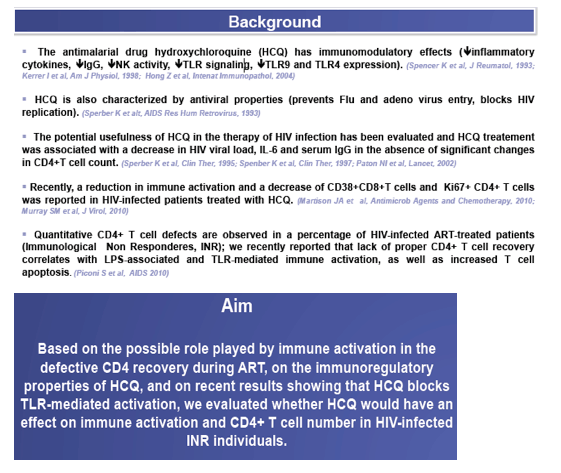
Matherials and Methods
Twenty ART-treated HIV-infected patients with an absolute CD4 count <200 cells/ml during the last 12 months of therapy and with suppressed viremia (< 37 HIV RNA copies/ml) were consecutively enrolled in the study. All patients were treated with combined antiretroviral therapy according to the current guidelines (NNRTI + PI or NRTI + NNRTI).
All patients received HCQ (400mg/die) for 6 months.
Virologic and immunologic parameters were evaluated at baseline, at the end of treatment, and two months after HCQ suspension.
RESULTS
Table 1. Clinical and epidemiological characteristics of HCQ-treated patients. Mean values, S.E. and ranges are shown.
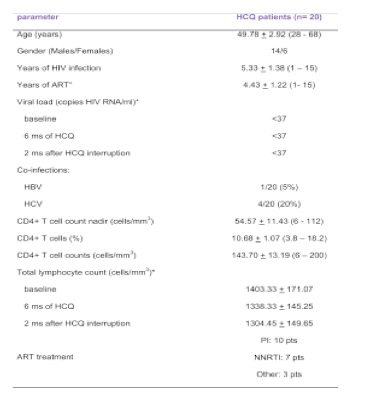
Figure 1. CD4+ T cells are increased in HCQ-treated patients. Percentage of CD4+ T cells (panel A) and CD4+ T
cell counts (panel B) in HIV-infected INR patients at baseline (white bars), after 6 months of HCQ (grey bars), and 2
months after HCQ interruption (black bars). Panel C shows unstimulated and env+gag-stimulated activated
Ki67+CD4+ T cells in HIV-infected INR patients analysed at the same timepoints. Mean values, S.E. and p values are
indicated.
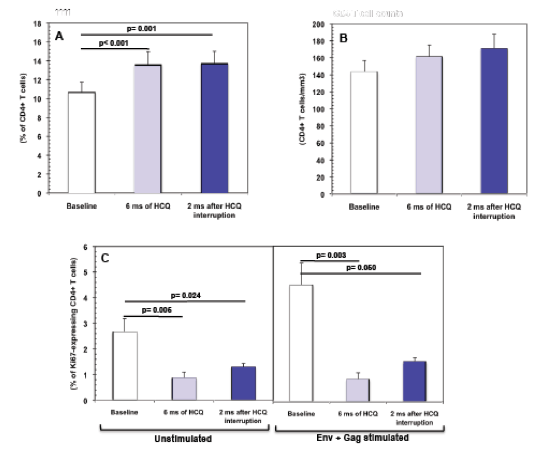
Figure 2. Effect of HCQ on activated CD8+ T cells and CD14+ monocytes. Percentage of CD8+DRII+ (panel A), CD8+CD69+ (panel B), and of CD8+CD38+CD45RO+ (panel C) T cells and percentage of CD14+CD69+ activated monocytes (panel D) in HIV-infected INR patients at baseline (white bars), after 6 months of HCQ (grey bars), and 2 months after HCQ
interruption (black bars). Mean values, S.E. and p values are indicated.
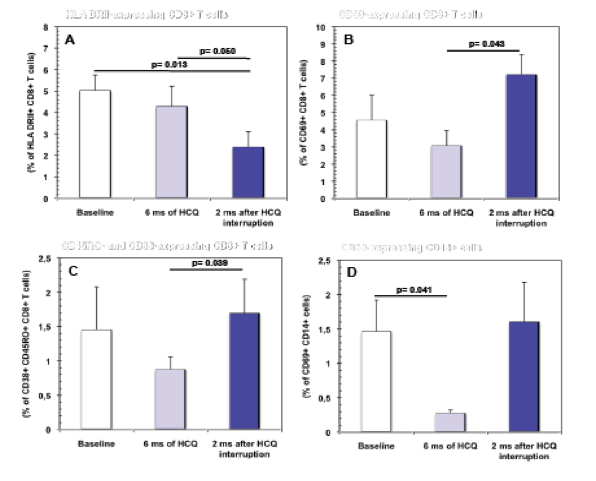
Figure 4. Treg and TLR-expressing Treg are increased in HCQ-treated patients. Percentage of unstimulated (panel A) and env+gag-stimulated (panel B) total, naive and activated Treg in HIV-infected INR patients at baseline (white bars), after 6 months of HCQ treatment (grey bars), and 2 months after HCQ interruption (black bars). Percentage of unstimulated (panel C), env+gag-stimulated (panel D) TLR2+ and TLR4+Tregs and LPS-stimulated TLR4+Tregs in the same patients. Mean values, S.E. and p values are indicated.
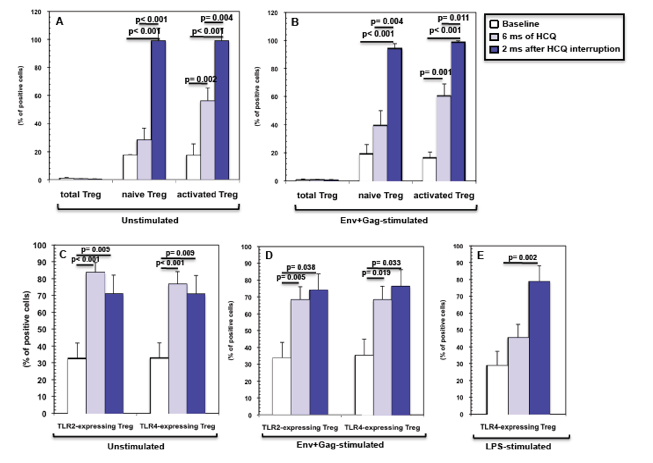
Figure 5. Plasmacytoid dendritic cells (pDC) are increased in HCQ-treated patients.
Percentage of pDC (panel A) and of IFNa-secreting pDC (panel B) in HIV-infected INR patients at baseline (white bars), after 6 months of HCQ treatment (grey bars), and 2 months
after HCQ interruption (black bars). Mean values, S.E. and p values are indicated.
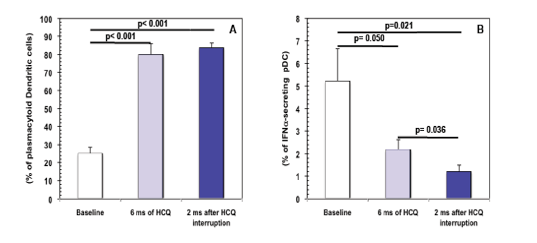
Figure 7. TLR4 and TLR7/8 signaling pathways are downmodulated in HCQ-treated
patients. TLR signaling pathway following TLR4 (panel A) and TLR7/8 stimulation (panel B) in in HIV-infected INR patients. Results obtained at baseline (white bars), after 6 months of HCQ treatment (grey bars), and 2 months after HCQ interruption (black bars) are shown. Mean values, S.E. and p values are indicated.
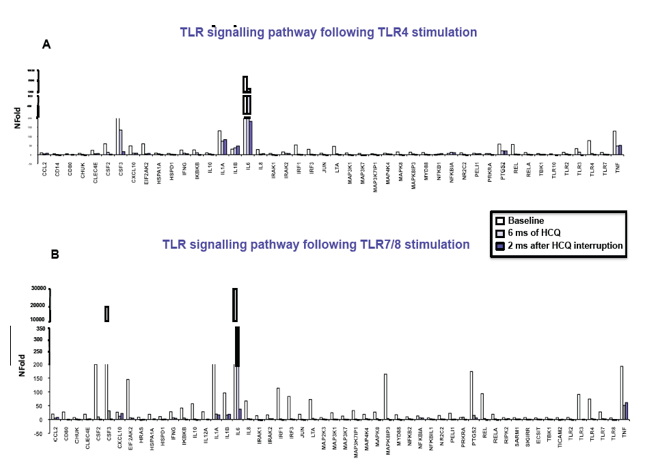
Figure 6. Plasma LPS levels are reduced in HCQ-treated patients. Plasma LPS concentrations in HIVinfected
INR patients at baseline (white bars), after 6 months of HCQ treatment (grey bars), and 2 months after HCQ interruption (black bars). Mean values, S.E. and p values are indicated.
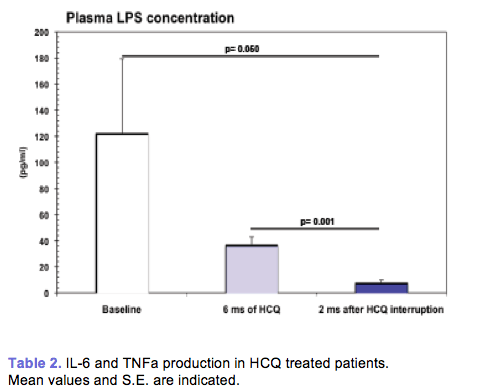
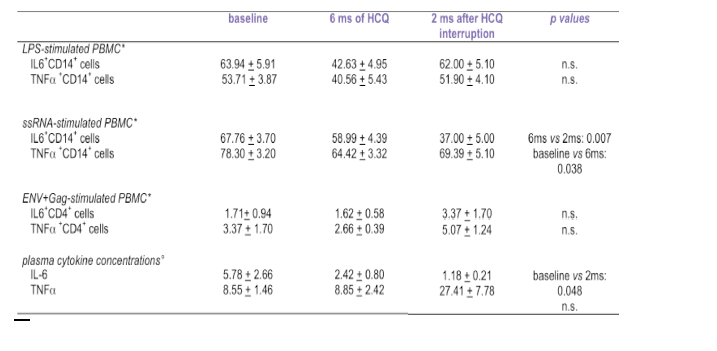
|
| |
|
 |
 |
|
|